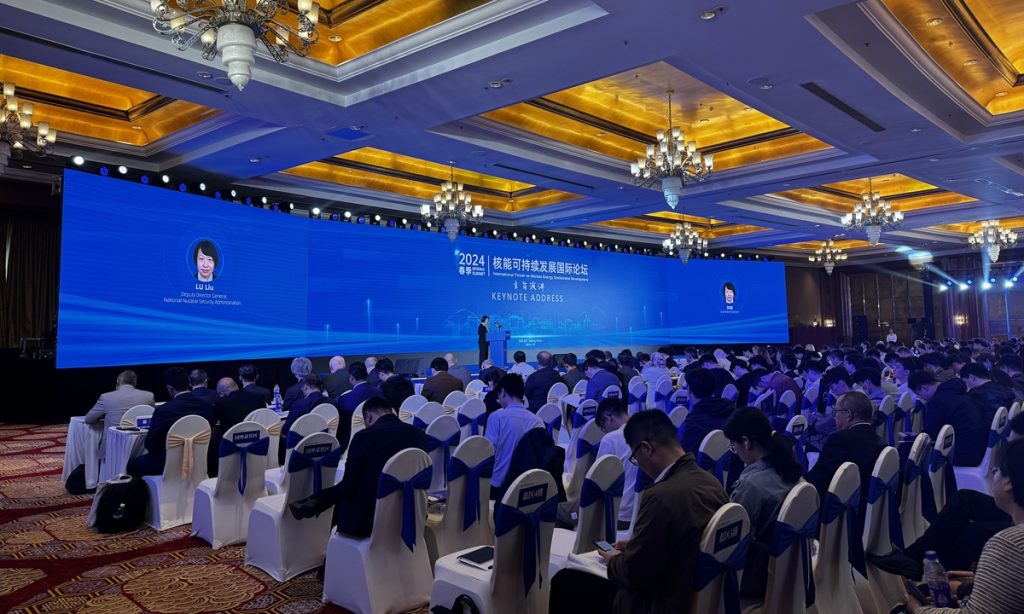Industrial report calls for optimizing China's nuclear power layout

As of the end of 2023, China is leading the world with 26 nuclear power units currently under construction, with a total installed capacity of 30.3 GW. However, a report released by the China Nuclear Energy Association (CNEA) highlights a discrepancy between the capacity of nuclear power and the requirements to meet the country's "dual carbon" goals. The report suggests that constructing nuclear power projects in central provinces, where the electricity supply gap is prominent, could help optimize the layout of nuclear power plants.
According to the report titled "China Nuclear Energy Development Report 2024", in 2023, China's commercial nuclear power units continued to operate safely and stably, with two new commercial nuclear power units added throughout the year, bringing the total number to 55 units with a total installed capacity of 57.03 GW, ranking third in the world.
Nuclear power accounts for 4.86 percent of the China's total electricity generation, resulting in a reduction of 340 million tons of annual carbon dioxide emissions, Wang Yiren, chief expert behind the report, said at the International Forum on Nuclear Energy Sustainable Development while releasing the report.
The country's commercial nuclear power units are located across eight provinces, mainly in coastal areas, with Guangdong, Fujian and Zhejiang ranking the top three regions in China in terms of total installed capacity, Wang noted. The nuclear power generation in provinces of Fujian, Liaoning, and Hainan account for over 20 percent of their total power generation in the provinces, with percentages of 27.3, 23.4, and 22.7 respectively, according to Wang.
The report highlighted the ongoing challenges in the development of nuclear power in China, including the discrepancy between installed capacity and the necessary requirements to meet "dual carbon" goals, the current layout of nuclear power construction falling short of building a new type of power system, and the absence of industrial scale for comprehensive utilization of nuclear energy.
To address the mismatch, the report calls to optimize the layout of nuclear power by initiating construction of nuclear power projects in central provinces with prominent electricity supply gaps.
Shu Yinbiao, a consultant from State Grid Corporation of China, said that it is advisable to initiate the pre-project and construction work for nuclear power projects in the central region around 2030. He suggested to include the sites for nuclear power plants where preliminary work has been completed within the national planning as soon as possible and construction should be started at the appropriate time.
The central region lacks the necessary conditions for large-scale development of wind and solar energy resources. Therefore, nuclear power has become a better choice to achieve sustainable energy supply and replace coal-fired power, Shu noted.
Additionally, the use of nuclear power should be regarded as a support for power supply in the northwest region of China, integrating wind, solar, and energy storage to achieve complementary and integrated development of power grid, according to Shu.
But China advocates the construction of nuclear power projects in coastal regions, Shu highlighted, considering resource conditions and energy demand and strong voltage support capabilities to power grid.
In the 11 provinces (cities) along the eastern coast, it is expected that by 2030, the total installed capacity of nuclear power will reach 120 million kilowatts, with the proportion of electricity generation reaching 18.5 percent, Shu noted.
Zhang Tingke, secretary-general of CNEA, said at the forum that it is estimated that by 2035, the proportion of nuclear power generation in China's total power structure will reach around 10 percent, which is equivalent to the current global average level, resulting in a reduction of approximately 900 million tons of carbon dioxide emissions.
As another effort to meet "dual carbon" goals, the report suggests to include nuclear power in the existing green low-carbon trading systems, helping to fully identify the clean and low-carbon attributes of nuclear power.
China's nuclear power development is in line with the global trend of using the clean energy to achieve climate goals and ensure energy security. One of the reasons for China to progress nuclear power in a fast and steady pace is because China regards nuclear safety as the lifeline of nuclear energy development.
Nuclear safety has been prioritized above all else. The three nuclear accidents in history have had a huge impact on global nuclear energy development, constantly reminding us to remain highly vigilant about nuclear safety," Zhang told the Global Times. There has never been a Level 2 or higher International Nuclear and Radiological Event Scale (INES)-rated operational event in China, according to Zhang.
To increase nuclear power security management system and boost the public's understanding toward nuclear power, the report also suggested including the atomic energy law as part of the country's legislative plan, as well as the revision of the Act on Prevention and Control of Radioactive Pollution and conducting legislative research on nuclear damage compensation laws.
Compared with major nuclear power countries around the world, in 2023, China's nuclear power units achieved higher scores for the WANO (World Association of Nuclear Operators) comprehensive index than the US, Russia, France, South Korea, and other major nuclear power countries. The index reflects the overall level of nuclear power units in terms of power generation capacity and safety performance, according to the report.